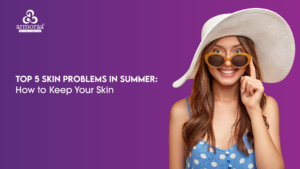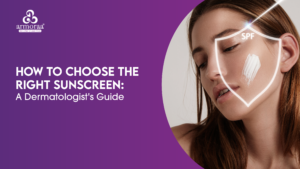Looking for your perfect hair care guide? Well, you’re at the right place! Don’t we all want perfect-looking hair that is frizz-free, shiny, and smooth? But it all comes down to the basic products that we use every other day. We all have different hair types and different concerns that each of us has to address. What works for one person might not necessarily work for the other. The various concerns could be excess oiliness or dryness, hair fall, dandruff on your scalp which should be tackled using shampoos that are meant for your hair. So today, let’s break it down for you and help you choose the right shampoo.
There are many reasons why your hair might be acting up currently. It can be due to products you have been using, the kind of lifestyle you live, or climate changes. Let’s start by looking into some of the basics of hair care by choosing the right shampoo. Just like knowing
which skincare ingredients address which skin problems, knowing which hair care ingredients work for which concern is just as important. So, the next time you have to pick a shampoo to treat your hair concern is made easy.
What does shampoo do?
Your scalp produces natural oils and sebum which is meant to protect your hair but excessive production can end up making your hair look greasy. The shampoo is considered to be a cleanser for your hair which should be chosen according to your hair type. Just
cleaning with water is not sufficient to remove excess oils. The following are some of the reasons why shampoo is important as part of your hair care routine:
– Removes sebum, dirt, environmental pollutants, sweat, dead cells, hair care products, styling creams
– Cleanses scalp
– Reduces dandruff
Why does shampoo have so many ingredients?
Every shampoo is made of several ingredients that compound together to tackle different concerns but there are some which are an absolute constituent for any shampoo, however the level and intensity of the ingredient may vary from brand to brand. All shampoos contain
detergents, conditioner, foaming agents, thickeners and opacifiers, sequestering agents, pH adjusters, preservatives, and special additives which are some of the bases that help create a healthy foundation for your hair.
Detergents –
The major action of detergent is to cleanse the scalp, remove dirt, sebum, pollutants, and product residues from your hair. A typical shampoo usually contains 2-4 detergents that are combined in shampoo to cleanse well, commonly known as lauryl sulphates & laureth sulphates. However, different detergents have different cleansing properties, some of which detergents are listed below:
Anionic Detergents:
SLS and laureth sulphates are known for their excellent cleansing
properties as it removes sebum and works well with both hard and soft water. Sarcosine is used as secondary detergents and also has excellent conditioning properties, but does not
remove sebum well.
Sulfosuccinates:
These detergents are usually added in shampoos that are made for oily hair.
Amphoteric:
You will find Cocamidopropyl betaine and sodium lauriminodipropionate on shampoos that are specially made for babies and to treat fine and damaged hair.
Natural Detergents:
Soapberries, soapnuts, soap bark, ivy agave, soapwort and sarsaparilla are some of the natural detergents used in shampoos that have poor cleansing properties but leaves your hair soft, shiny and manageable.
Cationic:
Long-chain amino esters, ammonia esters, cetyltrimethylammonium chloride – these ingredients are usually found in daily shampoos and shampoos that are designed for chemically damaged hair.
Non-Ionic Detergents:
These are mildest among all detergents and are usually combined as
secondary detergent. Polyoxyethylene fatty alcohol, polyoxyethylene sorbitol esters, and alkanol amides are the names found in shampoo.
Shampoo cannot be made without detergents, these are the agents which can cause dryness as it’s going to remove the oil and cause a static reaction in between hair strands. So, choose a shampoo according to the detergents used that suit your hair type.
All about conditioners –
Conditioner is considered the moisturizing component. For people who don’t have time to use a conditioner or are lazy to use one, a 2-in-1 shampoo can be used. This was first introduced in 1987 by Procter & Gamble which contained a conditioner as well.
What to look for in a conditioner?
Some of the common ingredients to look for in your 2-in-1 shampoos include hydrolyzed silk, animal protein, glycerin, dimethicone, simethicone, polyvinyl pyrrolidone, propylene glycol,and stearate konium chloride. Look for protein derived substances in shampoo as they help mend split ends. These kinds of shampoos are also ideal for dry, damaged, and chemically treated hair.
What’s inside your shampoo?
Foaming agents:
The main property of foaming agents is just for the sake of producing bubbles and doesn’t have any other role in shampoos. Because sebum inhibits bubble formation, when you cleanse for the second time you have bubble formation, but there are also times when we feel a shampoo doesn’t produce bubbles and so it doesn’t cleanse well. But, the fact is the bubble produced while applying shampoo is because of this agent added not because of cleansing well.
Thickeners and Opacifiers:
These are added just to increase the viscosity and to give a better cosmetic appearance to the shampoo. These do not play any role in the cleansing process. Glycol distearate, salt, PEG-150 distearate are the thickeners and opacifiers added.
Sequestering Agents:
Polyphosphates, ethylenediamine tetra-acetic acid – are the sequestering agents. Chelates are the magnesium and calcium ions. The presence of these leads to scum formation and causes dandruff, itching on the scalp.
pH Adjusters:
These adjust the pH equal to the scalp to reduce the dryness in your hair. The ideal pH balances are pH 5.5 which is maintained in shampoos that match the pH of the scalp. Glycolic acid and citric acid are the prime pH adjusters found in your shampoos.
Preservatives:
The name gives a shiver to a lot of people as most of you think preservatives are bad but on the contrary, preservatives are added to prevent contamination of the product so it doesn’t cause any damage to your hair or health. The main reason is that it resists germ growth.
Most of the last few ingredients that you see on your shampoo are list of preservatives which include Sodium benzoate, parabens, DMDM, hydantoin, tetrasodium EDTA, methylisothiazolinone, MIT, and Quaternium-1.
Special additives:
Few shampoos have additives like chemical sunscreen, vitamins like panthenol, pro vitamins, botanicals like tea tree, green tea extracts, and beer which serve only as a selling point. As shampoos are only left for 2-3 mins, there are no proven benefits from these agents and since the durations left on the scalp is less there is no harm in using shampoos with these agents.
Now that we have taken a deep dive into the ingredients, let us understand which kind of shampoo is the best for your hair type. To make it simple for you, most of the shampoos mention – for normal hair, for dry hair, for treated hair, for coloured hair, etc.
Normal hair shampoo
Choose a shampoo that cleans well and usually has anionic detergents like SLS and laureth sulphates and provides minimal conditioning.
Dry hair shampoo
These are meant for chemically treated hair, frizzy hair or split ends. They contain mild cleansers and detergents which have mild cleansing effects like sarcosine, amphoteric detergents, or natural detergents that provide good conditioning.
Oily hair shampoo
These shampoos mostly contain detergents that cleanse well like lauryl sulfates, sulfosuccinates. Use a conditioner after shampooing as these detergents remove the oil completely and leave your hair dry.
Everyday shampoo
Ideal for people who wash their hair daily. Usually contains mild detergents but no conditioner. Hence using a conditioner is important to keep your hair in good condition, as you’re removing the sebum which is a natural conditioner.
Deep cleansing shampoo
These are used to remove the styling products residues, like sprays, mousse, gels, etc. As they contain strong detergents it removes the products well and should be used only weekly once after which you should use a conditioner.
Medicated shampoo
These contain ketoconazole, selenium sulfide, coal tar, ciclopirox olamine, caffeine, etc., and are used to reduce dandruff, hair fall. It is ideal to use these shampoos only on a doctor’s advice.
Baby shampoo
These contain mild detergents which don’t sting your eye.
Professional shampoo
These can be used before bleaching, coloring, or any other treatments as they are more concentrated than regular shampoos to remove the chemicals applied. However, these are not advised for at-home use.
It is important to always choose a shampoo according to your hair type. It isn’t necessary your hair stays the same throughout, it might get better or might worsen due to external conditions such as sun, changing weather and habits. It is important to change your
shampoo if you have gotten any chemical treatments done such as keratin, smoothening, straightening, perming or colouring as these require specific ingredients for cleansing and the shampoos are altered according to your hair treatment.
In the quest for perfect hair, take a step to look closely at what you use and invest in good products that actually make a difference by strengthening and nourishing the hair. Make sure you’re not over-washing your hair and using conditioners to maintain the balance of your hair. You will start noticing a difference in your hair only after a couple of weeks of using the product, so don’t hurry in making assumptions when you start using a new product.




